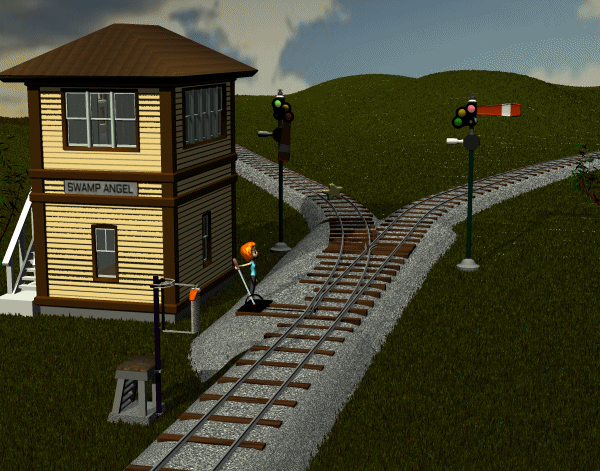Thursday, December 24, 2020
Interesting technique but not exactly new.
Headline: Researchers develop new way to break reciprocity law.
In this case reciprocity means the expected two-way communication in normal air and wires. If I can see you, you can see me.
The proposed method is presumably new at the microscopic level for optics, but it's extremely old and ordinary at larger scales.
 Stationmaster Polistra is controlling the switch so she can send trains only to the left track and receive only from the right track. If you were a few miles back from the station, you couldn't see the switch or Polistra. You'd only see a single track, and you'd see trains mysteriously coming and going without colliding. People at the end of the left track could only receive, and people at the end of the right track could only send.
Duplex telegraphy systems are a bit older than railroad switches. Same trick. Use polarity of signal on a wire, or different frequencies on wireless, to ONLY send or ONLY receive on the same channel.
Tyndall's observations showed how a similar switch can happen acoustically. When you have inversions and interfaces between masses of different temperature or humidity, you can arrange the source and receiver for switch-like communication. When the line from the sound to the listener is parallel to a boundary, the sound will be channeled to your ear. When the line is perpendicular, the sound is blocked.
Presumably these researchers have found a way to wiggle inversion boundaries in a transparent material, perhaps using LCD-style magnetically shaped crystals.
Stationmaster Polistra is controlling the switch so she can send trains only to the left track and receive only from the right track. If you were a few miles back from the station, you couldn't see the switch or Polistra. You'd only see a single track, and you'd see trains mysteriously coming and going without colliding. People at the end of the left track could only receive, and people at the end of the right track could only send.
Duplex telegraphy systems are a bit older than railroad switches. Same trick. Use polarity of signal on a wire, or different frequencies on wireless, to ONLY send or ONLY receive on the same channel.
Tyndall's observations showed how a similar switch can happen acoustically. When you have inversions and interfaces between masses of different temperature or humidity, you can arrange the source and receiver for switch-like communication. When the line from the sound to the listener is parallel to a boundary, the sound will be channeled to your ear. When the line is perpendicular, the sound is blocked.
Presumably these researchers have found a way to wiggle inversion boundaries in a transparent material, perhaps using LCD-style magnetically shaped crystals.
The team theoretically demonstrated that, if the medium is shaped into an asymmetric structure and its physical property varies globally in time, the signal generated by source A can be received by source B but not the other way around. This creates a strong nonreciprocal effect, since the signal from Source B cannot be received by source A.At the macro scale, this trick has been used for many centuries, by diversion dams in canals, Y-valves in plumbing, and switches in railroads.
 Stationmaster Polistra is controlling the switch so she can send trains only to the left track and receive only from the right track. If you were a few miles back from the station, you couldn't see the switch or Polistra. You'd only see a single track, and you'd see trains mysteriously coming and going without colliding. People at the end of the left track could only receive, and people at the end of the right track could only send.
Duplex telegraphy systems are a bit older than railroad switches. Same trick. Use polarity of signal on a wire, or different frequencies on wireless, to ONLY send or ONLY receive on the same channel.
Tyndall's observations showed how a similar switch can happen acoustically. When you have inversions and interfaces between masses of different temperature or humidity, you can arrange the source and receiver for switch-like communication. When the line from the sound to the listener is parallel to a boundary, the sound will be channeled to your ear. When the line is perpendicular, the sound is blocked.
Presumably these researchers have found a way to wiggle inversion boundaries in a transparent material, perhaps using LCD-style magnetically shaped crystals.
Stationmaster Polistra is controlling the switch so she can send trains only to the left track and receive only from the right track. If you were a few miles back from the station, you couldn't see the switch or Polistra. You'd only see a single track, and you'd see trains mysteriously coming and going without colliding. People at the end of the left track could only receive, and people at the end of the right track could only send.
Duplex telegraphy systems are a bit older than railroad switches. Same trick. Use polarity of signal on a wire, or different frequencies on wireless, to ONLY send or ONLY receive on the same channel.
Tyndall's observations showed how a similar switch can happen acoustically. When you have inversions and interfaces between masses of different temperature or humidity, you can arrange the source and receiver for switch-like communication. When the line from the sound to the listener is parallel to a boundary, the sound will be channeled to your ear. When the line is perpendicular, the sound is blocked.
Presumably these researchers have found a way to wiggle inversion boundaries in a transparent material, perhaps using LCD-style magnetically shaped crystals.
